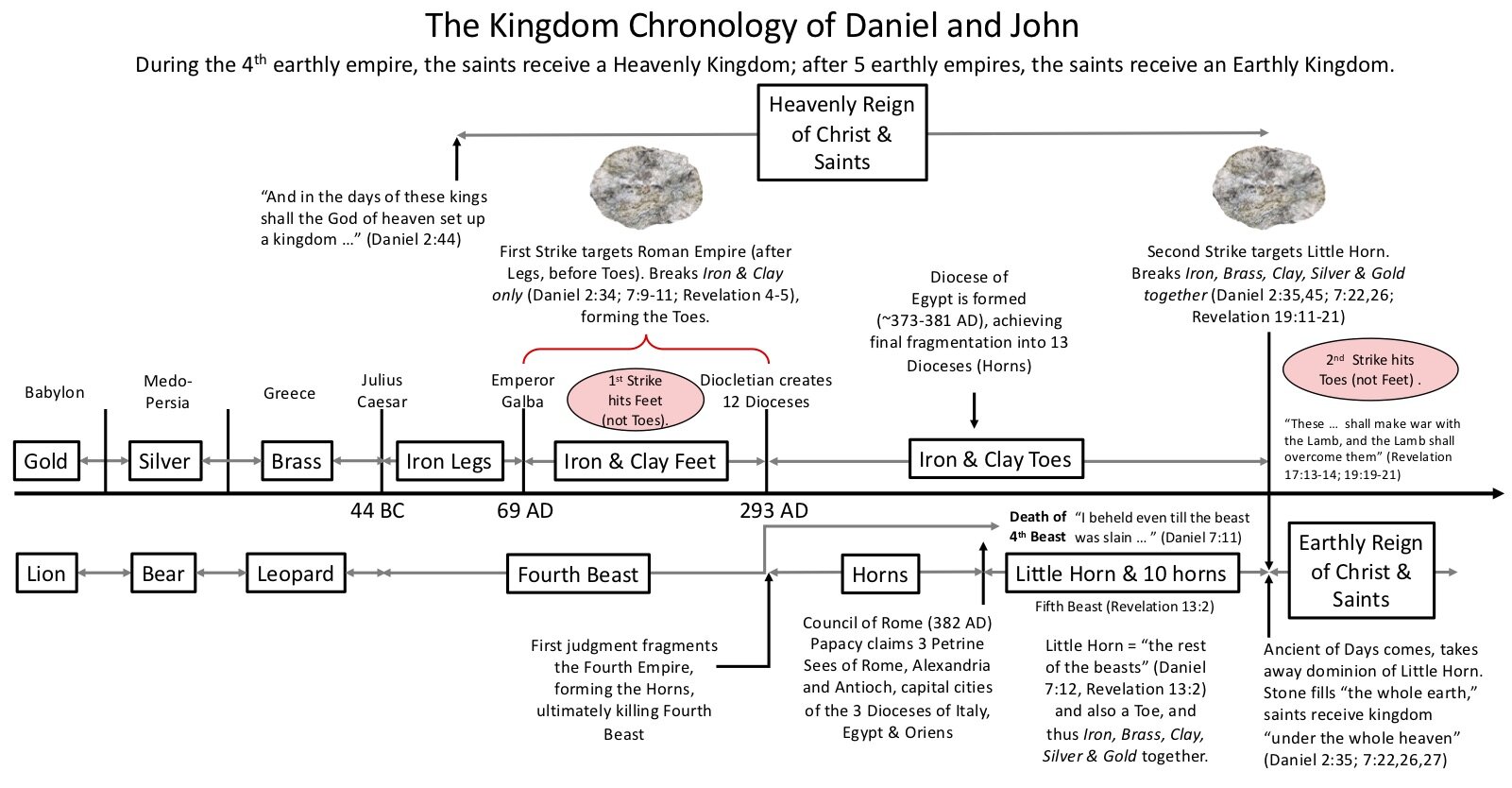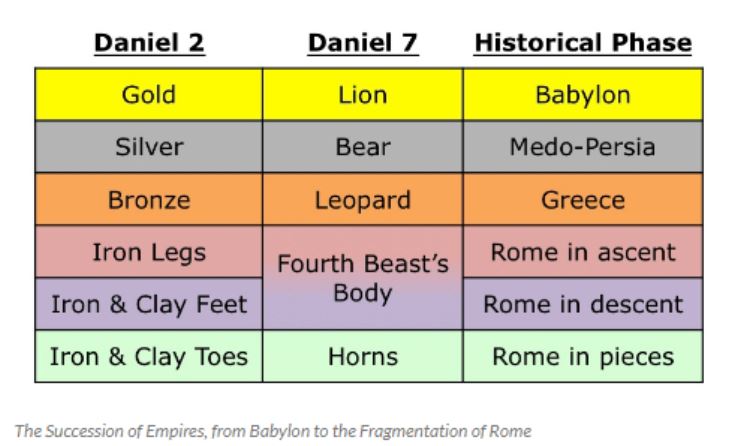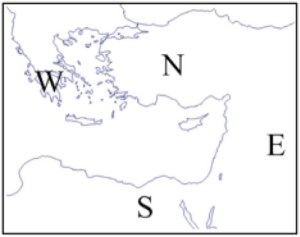
This eschatological timeline is a summary and expansion of Timothy F. Kauffman’s work at the Out of His Mouth blog. This may one day be reworked into multiple parts. It is intended to be a work-in-progress and will be expanded as time goes by.
The timeline is broken down into two partially overlapping sections. The first primarily covers the statue and creatues prophecies of Daniel and the prophecies of Revelation that refer to it. The second primarily covers the seven seals, seven trumpets, and the seven bowls.
NOTE: even if the timeline is wrong—especially the timing of the seals/trumpets/bowls in Revelation—there is little question as to the identity of the Beast, the identification of which does not require any knowledge of the specific scroll, trumpet, and bowl judgments.
Daniel

Babylon: Gold/Lion
Lifted up after Nebuchadnezzar’s humiliation (605-538BC)
605-562BC: Nebuchadnezzar II
562-560BC: Amel-Marduk
560-556BC: Neriglissar
556-556BC: Labashi-Marduk
556-539BC: Nabonidus
Medo-Persia: Silver/Bear/Ram
Raised up on one side: Persian dominance (538-330BC)
538-530BC: Cyrus the Great
530-522BC: Cambyses II
522-522BC: Bardiya
522-486BC: Darius the Great
485-465BC: Xerxes I — Book of Esther
465-424BC: Artaxerxes I
424-404BC: Darius II
404-358BC: Artaxerxes II
358-338BC: Artaxerxes III
338-336BC: Artaxerxes IV
336-330BC: Darius III
330-329BC: Artaxerxes V
Greece: Bronze/He-Goat/Notable horn of He-Goat
United empire: 330-323BC
336-323BC: Alexander the Great [Daniel 11:1-3]
Greece: Bronze/Leopard/He-goat/Four Horns of He-Goat
Divided empire: 323-44BC
Ended with four heads/divisions, indentified by the cardinal points.

323-317BC: Philip III Arrhidaios
323-280BC: Establishment of Alexandrian Frame (Daniel 11:4)
336-280BC: Ptolemy to the South; Seleucus (Daniel 11:5)
252-188BC: Seleucids, Phase I: North (Daniel 11:6-18)
188-163BC: Seleucids, Phase II: East (Daniel 11:19-39)
175-163BC: Antiochus IV Epiphanes, the Little Horn of Daniel 8 (not Daniel 7)
175-164BC: 2,300 literal days (intercalation implies literal days)
167-164BC: 1,290 literal—due to intercalation—days, then another 45 to get to 1,335 days, cessation of sacrifices, Abomination of Desolation (Statue of Jupiter) in the Temple. (Greek antagonist of Daniel 8, 9, and 11)
67-48BC: Pompey vs Pirates, Mithridates, Tigranes (Daniel 11:40-45)
47-44BC: Ptolemy XIV
Roman Empire: Iron Legs/Fourth Beast
Strong Roman Empire in ascent (Julius Caesar 44B.C. to Galba 69A.D.)
Julius Caesar (declared Dictator perpetuo in 44 B.C.)
Civil Wars (44 – 27 B.C.)
Augustus (27 B.C. – 14 A.D.), Julius’ grand-nephew
Tiberius (14 – 37 A.D.), Augustus’ step-son
Birth, Ministry, Death, Resurrection, and Ascension of Jesus
“And if I go and prepare a place for you, I will come again, and receive you unto myself; that where I am, there ye may be also.” — John 14:3
“And in the days of these kings shall the God of heaven set up a kingdom” — Daniel 2:44
Caligula (37 – 41 A.D.), Tiberius’ grand-nephew
Claudius (41 – 54 A.D.), Caligula’s uncle
Nero (54 – 68 A.D.), Claudius’ grand-nephew
The Apocalypse of John is written:
“And there are seven kings: five are fallen, and one is, and the other is not yet come” — Revelation 17:10a
Galba (68-69 A.D.), related by marriage and adoption
Roman Empire: Iron & Clay Feet/Fourth Beast
Partly-strong Rome in descent (Ortho 69AD to Diocletian 293AD)
Over this period, the first stone strike grinds the empire down into toes (Daniel 2:34; 7:9-11; Revelation 4-5). Roman succession is no longer by family line:
“And whereas thou sawest iron mixed with miry clay, they shall mingle themselves with the seed of men: but they shall not cleave one to another, even as iron is not mixed with clay.” — Daniel 2:43
Otho (Jan – Apr 69 A.D.), Etruscan (non-Roman) lineage
Vitellius (Apr – Dec 69 A.D.), of Latium or possibly common lineage
Vespasian (69 – 79 A.D.), a commoner
Transfer of the Heavenly Kingdom from the Jews (A.D. 70) which the saints receive. “in the days of these kings shall the God of heaven set up a kingdom, which shall never be destroyed” (Daniel 2:43-44)
Titus (79 – 81 A.D.), Vespasian’s son
Domitian (81 – 96 A.D.), Titus’ brother
Nerva (96 – 98 A.D.), Coceii family, distantly related to the Julio-Claudian dynasty
Trajan (98 – 117 A.D.), of Hispanic and Italian stock
Hadrian (117 -138 A.D.), of Hispanic, possibly Italian stock
Antoninus (138 – 161 A.D.), from Nimes (southern France)
…39 more…
Diocletian (296AD)
The stone that struck the Roman Empire had ground it into fragments from which the Roman Church would arise. The initial emergence of the horns and toes takes place when Diocletian reorganizes the empire into Tetrarchs over 12 dioceses in 296AD. They are not yet in their final configuration of ten.
Roman Empire: Iron & Clay Toes/Horns
Rome in pieces — (296AD to 395AD)
296-382AD: Roman Empire reorganized from 12 (initial) to 13 (final) dioceses each ruled by its own vicarii:
Three Horns / Three Petrine Seats
Diocese of the East (principal city: Antioch)
Diocese of Egypt (principal city: Alexandria) — Formed from the Diocese of the East (~373-381AD)
Diocese of Italy (principal city: Rome)
Ten Horns / Ten Toes
Diocese of Asia
Diocese of Pontica
Diocese of Thrace
Diocese of Macedonia
Diocese of Dacia
Diocese of Pannonia/Illyricum
Diocese of Africa
Diocese of Gaul/Septem Provinciæ
Diocese of Spain
Diocese of Britain
See here for more information.
380AD: Christianity becomes the official state religion of Rome.
382AD: Council of Rome; Emergence of Little Horn (Daniel 7; not Daniel 8)
Three dioceses vying for supremacy: Antioch, where Peter was first, Rome where Peter was last, and Alexandria where Mark was. Pope Gregory the Great in 590 to 604 A. D. declared it three bishops in a See of One. Pope Bendict XVI declared Peter’s apostolic succession to run through these three.
Roman Catholicism (little horn) claims 3 dioceses: Rome (Italy), Alexandria (Egypt), and Antioch (Oriens); the Three Petrine Sees. Little Horn does not yet claim civil power of the sword.
382-395AD: Roman Empire rules with 10 horns (dioceses) alongside the little horn that swallowed up the 3 horns (dioceses).
“And the ten horns which thou sawest are ten kings, which have received no kingdom as yet; but receive power as kings one hour with the beast.” (Revelation 17:12)
395AD: Transfer of the Earthly Kingdom—the fourth beast—to the small horn—the Antichrist; the fifth beast—which Roman Catholicism receives. Roman Catholicism takes up the civil power of the sword.
“I beheld even till the [fourth] beast was slain, and his body destroyed, and given to the burning flame. As concerning the rest of the [first three] beasts, they had their dominion taken away: yet their lives were prolonged for a season and time.” — Daniel 7:11-12
“And the [fifth] beast which I saw was like unto a leopard, and his feet were as the feet of a bear, and his mouth as the mouth of a lion: and the dragon gave him his power, and his seat, and great authority.” — Revelation 13:2

Papal Roman Catholicism: Little Horn
Little horn is the Roman antagonist of Daniel 7
395-1655AD, or 42-months, 1,260 prophetic days, 1,260 literal years.
NOTE: The day-year principle applies due to the lack of intercalation.
Perseverance of the Vaudois (and various predecessors) in the Alpine Valleys
Little Horn “shall wear out the saints of the most High”
Beast is free to “continue” (“do”) for “forty and two months” (Revelation 13:5)
Beast is given “to make war with the saints, to overcome them” (Revelation 13:7)
Woman [Church] “is nourished for a time, and times, and half a time, from the face of the serpent [Satan]” (Revelation 12:14)
1655AD: Massacre of the Waldensians. Survivors scatter through Europe. Little Horn reduced to pre-395AD dominions and abandons Papal civil and military power. Sudden rapid decline of Papal influence in Europe.
Revelation
The Seven Seals (Revelation 6-8)
The seals are described in detail here.
Seal 1: 226 A.D. – Rise of the Sassanid Empire
Seal 2: 235 A.D. – The Crisis of the Third Century
Seal 3: 301 A.D. – Diocletian’s Edict on Maximum Prices (“Barley, Oil, and Wine”)
Seal 4: 303 A.D. – The Diocletianic Persecution
Seal 5: 311 A.D. – The “pretended relaxation”
Seal 6: 358 A.D. – The earthquake of Nicomedia
Seal 7: 358 A.D. – The burning of Nicomedia
The Seven Trumpets (Revelation 8-9)
Trumpet 1: 359 A.D. – Eden Burning
Trumpet 2: 365 A.D. – The Egyptian Tsunami
Trumpet 3: 382-404 A.D. – The Latin Vulgate
Trumpet 4: 536 A.D. – The Mysterious Persistent Fog (Volcanic winter of 536)
Trumpet 5: 1095-1245 A.D. – The “Holy Land Crusading Spirit”
Trumpet 6: 1914-1945 A.D. – World Wars I & II
Trumpet 7: Still to come in the future, after the seventh bowl.
Second strike of the stone targets the little horn—the fifth beast—breaking the iron, brass, clay, silver, and gold together (Daniel 2:35,45; 7:22,26; Revelation 19:11-21)
The Seven Bowls (Revelation 16)
Bowl 1: The Stigmata (1224 A.D. – present)
Bowl 2: The Plague of Scurvy (1453 – late 1700s A.D.)
Bowl 3: The Dogma of Papal Infallibility (1870 A.D.)
Bowl 4: Scorching by the Sun at Fátima (1917 A.D.)
Bowl 5: The first (and only) formally ex cathedra papal statement in Roman Catholic history (1950 A.D.).
Bowl 6: Possibly ongoing
Bowl 7: Still to come in the future. Precedes the seventh trumpet.

Pingback: Eschatology: The Seven Kings
Pingback: Barley, Oil, and Wine
Pingback: The Occult in the Mainstream Church, Part 2
Pingback: Numerology - Derek L. Ramsey
Thankyou! Excellent summary and easy to understand.